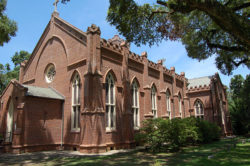Grace Episcopal Church
Organized in 1827, Grace Church serves Louisiana's second oldest Episcopal parish.

Courtesy of Wikimedia Commons
Grace Episcopal Church. Z28scrambler (creator)
Grace Episcopal Church in St. Francisville serves Louisiana’s second-oldest Episcopal parish, which was organized in 1827. The red brick church replaced an original, smaller structure and has a square apse, short transepts, a single square battlemented tower, narrow stepped buttresses, lancet windows, and a small projecting portico—features typical of the ideal Gothic Revival parish church and advocated in popular writings by architects Frank Willis and Richard Upjohn in the 1850s.
Charles N. Gibbons was the church’s architect. His design of the façade—with its portico, flanking windows, and decorative brick moldings—suggests an interior arrangement of a central nave and side aisles, so it is a surprise upon entering to find a single, wide, hall-like space. Tall, narrow stained-glass windows illuminate the interior; the flat ceiling is ornamented with rococo medallions, which are rather incompatible with the church’s Gothic appearance, and an arcade of three pointed arches separates the apse from the nave. The two-manual tracker-type pipe organ (1860) was manufactured by Pilcher Brothers of St. Louis, Missouri.
It is believed that the live oak trees on the church grounds were planted in 1855, when installation of the wrought-and cast-iron fence surrounding the cemetery was begun. The earliest surviving grave dates from 1858; several graves are surrounded by their own elaborate cast-iron fences, which combine with the ancient oaks and feathery Spanish moss to create a scenic ambience that lures both artists and photographers. Grace Church was damaged in 1864 during the Civil War, when the tower was used as a target for the shelling of St. Francisville. The church was restored in 1893.
Adapted from Karen Kingsley’s Buildings of Louisiana, part of the Buildings of the United States series commissioned by the Society of Architectural Historians (www.sah.org) and published by Oxford University Press.
